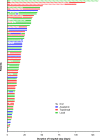Hospital Admissions, Transfers and Costs of Guillain-Barré Syndrome
- PMID: 26859880
- PMCID: PMC4747559
- DOI: 10.1371/journal.pone.0143837
Hospital Admissions, Transfers and Costs of Guillain-Barré Syndrome
Abstract
Background: Guillain-Barré syndrome (GBS) has a highly variable clinical course, leading to frequent transfers within and between hospitals and high associated costs. We defined the current admissions, transfers and costs in relation to disease severity of GBS.
Methods: Dutch neurologists were requested to report patients diagnosed with GBS between November 2009 and November 2010. Information regarding clinical course and transfers was obtained via neurologists and general practitioners.
Results: 87 GBS patients were included with maximal GBS disability score of 1 or 2 (28%), 3 or 4 (53%), 5 (18%) and 6 (1%). Four mildly affected GBS patients were not hospital admitted. Of the 83 hospitalized patients 68 (82%) were initially admitted at a neurology department, 4 (5%) at an ICU, 4 (5%) at pediatrics, 4 (5%) at pediatrics neurology and 3 (4%) at internal medicine. Median hospital stay was 17 days (IQR 11-26 days, absolute range 1-133 days). Transfers between departments or hospitals occurred in 33 (40%) patients and 25 (30%) were transferred 2 times or more. From a cost-effectiveness perspective 21 (25%) of the admissions was suboptimal. Median costs for hospital admission of GBS patients were 15,060 Euro (IQR 11,226-23,683). Maximal GBS disability score was significantly correlated with total length of stay, number of transfers, ICU admission and costs.
Conclusions: Hospital admissions for GBS patients are highly heterogeneous, with frequent transfers and higher costs for those with more severe disease. Future research should aim to develop prediction models to early identify the most cost-effective allocation in individual patients.
Conflict of interest statement
Figures


References
-
- Hughes RA, Cornblath DR. Guilain-Barre syndrome. Lancet. 2005. November;366(9497):1653–66. - PubMed
-
- Hughes RA, Rees JH. Clinical and epidemiologic features of Guillain-Barre syndrome. J Infect Dis. 1997. December;176 Suppl 2:S92–8. - PubMed
-
- Van der Meché FG, Schmitz PI. A randomized trial comparing intravenous immune globulin and plasma exchange in Guillain-Barré syndrome. Dutch Guillain-Barré Study Group. N Engl J Med. 1992. April;326(17):1123–9. - PubMed
-
- Hughes RA, Swan AV, Raphaël JC, Annane D, Van Koningsveld R, Van Doorn PA. Immunotherapy for Guillain-Barré syndrome: a systematic review. Brain. 2007. September;130(Pt 9):2245–57. - PubMed
-
- Van Koningsveld R, Van Doorn PA, Schmitz PI, Van der Meché FG. Changes in referral pattern and its effect on outcome in patients with Guillain-Barré syndrome. Neurolgy. 2001. February;56(4):564–6. - PubMed
MeSH terms
Associated data
LinkOut - more resources
Full Text Sources
Other Literature Sources
Medical

